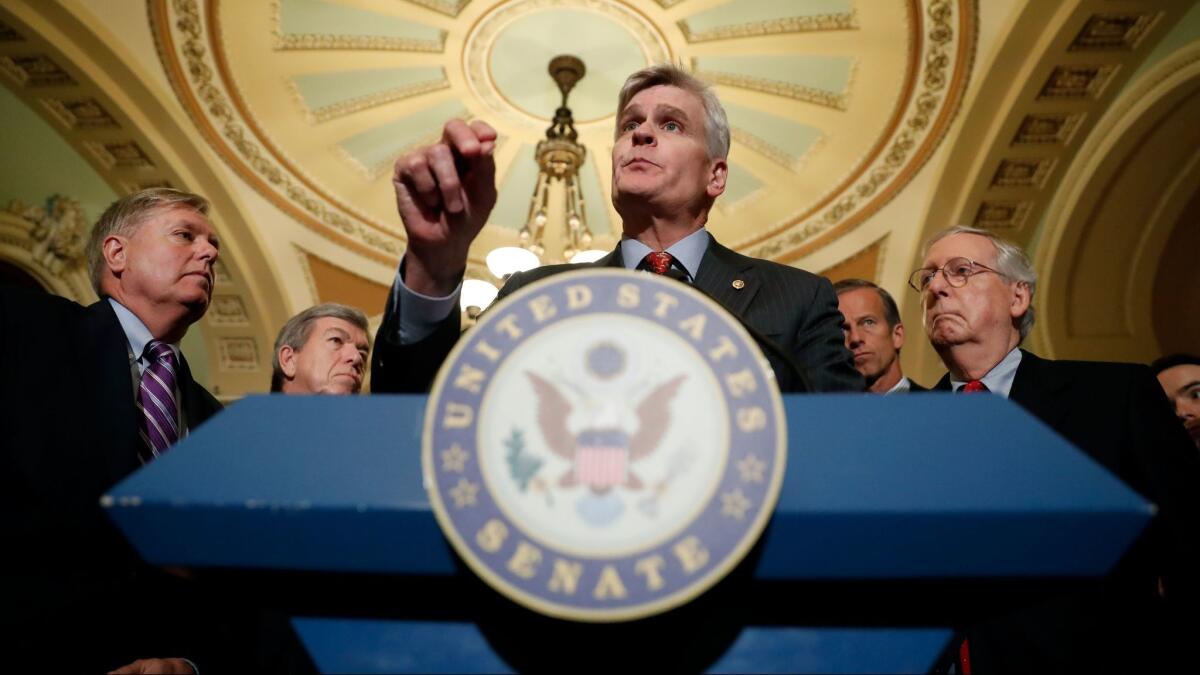Editorial: Graham-Cassidy: Another day, another lousy GOP healthcare bill

- Share via
It’s “Groundhog Day” for congressional Republicans: Rush out a bill to repeal and replace Obamacare, see it fail, rush out a bill again, see it fail, rush out a third bill, see it fail — following the same basic playbook over and over in the hope that somehow the end result will change.
The latest proposal — by Sens. Lindsey Graham (R-S.C.), Bill Cassidy (R-La.), Dean Heller (R-Nev.) and Ron Johnson (R-Wis.) — suffers from the same fundamental problems as all of its predecessors. Aiming to lower insurance costs for the healthy, it would allow states to herd people with preexisting conditions or potentially expensive risks — say, women who might want maternity coverage — into insurance gulags with egregiously high premiums.
Not content just to roll back the expansion of Medicaid in the Affordable Care Act, it would cap funding in a way that would threaten services for Medicaid’s core beneficiaries, including impoverished disabled people and families. Pandering to social conservatives, it would cut off federal funding for Planned Parenthood and deny low-income Americans subsidies for private insurance policies that cover abortion (a ban that would rule out aid to Californians, given that state law mandates such coverage in every policy).
Although it would overhaul the way millions of Americans pay for health insurance and treatment, the measure has undergone no formal public scrutiny and only limited expert analysis. And if it nevertheless managed to become law, Graham-Cassidy would produce many of the same unwelcome results as its failed forebears: more uninsured Americans, and millions of others facing higher premiums and deductibles for the coverage they have today.
Just like food and housing, healthcare costs more in some states than others — and in some cases, much more.
What makes the Graham-Cassidy bill different are its cost and complexity, as well as the blatant shifting of taxpayer dollars from (mostly) blue states to red ones. Unlike the other proposals, it would keep almost all of the tax hikes in the Affordable Care Act in place, raising about $1.2 billion by 2026. The money would flow to states in the form of block grants with few strings attached, in the hope of spurring innovative approaches to insuring lower-income people and those not covered by group plans at work. But in another twist, it would change where those healthcare dollars went, gradually transferring federal aid from the 31 states that had expanded Medicaid to the 19 that had not.
Although the block grants technically would have to be spent on healthcare-related programs, such as subsidies to attract more insurers and bring down premiums, they wouldn’t actually require states to spend more than they’re already spending. Instead, the grants could free states to spend more of their own dollars on roads, prisons or other programs instead of healthcare.
The big winners would be deeply red states that have spent comparatively little on healthcare for their residents, such as Oklahoma, Mississippi and Kansas. The losers would be states with large healthcare budgets, such as California and Massachusetts.
The bill’s sponsors frame this as basic fairness, as money would be provided to almost every state at the same rate per low-income resident. But that’s hogwash. Just like food and housing, healthcare costs more in some states than others — and in some cases, much more. The measure also uses a formula for divvying up dollars that would make it difficult, if not impossible, for a state to keep covering impoverished people who don’t qualify for traditional Medicaid. So the “freedom” it provides for state innovation doesn’t seem to extend to that particularly vulnerable portion of the population.
Oh, and by the way, the new block grants would evaporate in 2027 — a gimmick to meet a federal requirement that such measures not raise the federal deficit over the long term. But the move would only force another bitter fight over healthcare policy before the grants run out, while making a mockery of long-term planning for doctors and health plans.
It’s hard to say with much precision how many people might lose coverage under Graham-Cassidy, considering how many decisions would be left up to the states. The one thing it would be sure to do is make increasingly deep cuts in federal support for Medicaid and insurance subsidies while doing absolutely nothing to slow the rising cost of healthcare.
There are problems in some states’s insurance markets that need to be addressed, and a bipartisan effort to do so showed promise before Republicans pulled the plug on it this week. The Graham-Cassidy proposal, on the other hand, may only make the individual insurance market more unstable — and inhospitable to people with preexisting conditions or limited means. There’s a lot to be said for states’ role as laboratories of innovation in healthcare. But supplying less money to cover more costs is just a formula for failure.
Follow the Opinion section on Twitter @latimesopinionand Facebook.
More to Read
A cure for the common opinion
Get thought-provoking perspectives with our weekly newsletter.
You may occasionally receive promotional content from the Los Angeles Times.










